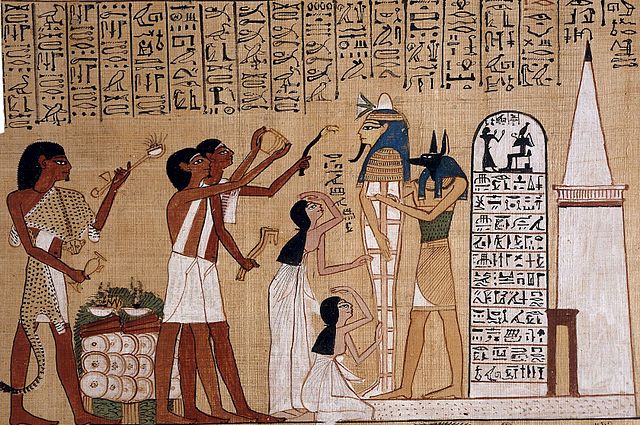Ancient Egyptian afterlife beliefs
Ancient Egyptian afterlife beliefs were centered around a variety of complex rituals that were influenced by many aspects of Egyptian culture. Religion was a major contributor, since it was an important social practice that bound all Egyptians together. For instance, many of the Egyptian gods played roles in guiding the souls of the dead through the afterlife. With the evolution of writing, religious ideals were recorded and quickly spread throughout the Egyptian community. The solidification and commencement of these doctrines were formed in the creation of afterlife texts which illustrated and explained what the dead would need to know in order to complete the journey safely.

This detail scene from the Papyrus of Hunefer (c. 1375 BC) shows Hunefer's heart being weighed on the scale of Maat against the feather of truth, by the jackal-headed Anubis. The ibis-headed Thoth, scribe of the gods, records the result. If his heart is lighter than the feather, Hunefer is allowed to pass into the afterlife. If not, he is eaten by the waiting Ammit. Vignettes such as these were a common illustration in Egyptian books of the dead.
The Opening of the Mouth ceremony being performed on a mummy before the tomb. Anubis attending the mummy of the deceased. Extract from the Papyrus of Hunefer, a 19th-Dynasty Book of the Dead (c. 1300 BC)
Pyramid Text within the burial pyramid of Teti I
The 11th hour of the book Amduat
The Duat is the underworld in ancient Egyptian mythology. It has been represented in hieroglyphs as a star-in-circle: 𓇽. The god Osiris was believed to be the lord of the underworld. He was the first mummy as depicted in the Osiris myth and he personified rebirth and life after death. The underworld was also the residence of various other gods along with Osiris.
Judgment scene from the Book of the Dead from the Papyrus of Hunefer. In the three scenes from the Book of the Dead (version from ~1275 BCE) the deceased Hunefer is taken into the judgment hall by the jackal-headed Anubis. The next scene is the weighing of his heart, with Ammit awaiting the result and Thoth recording. Next, the triumphant Hunefer, having passed the test, is presented by the falcon-headed Horus to Osiris, seated in his shrine with
A section of the Egyptian Book of the Dead that is written on papyrus, showing the Weighing of the Heart in the Duat, where Anubis can be seen on the far right. The scales are shown with the feather balance, and Ammit awaits hearts that she must devour. The presence of Osiris at the gateway to the paradise of Aaru dates the papyrus to a late tradition of the myth.
Af or Afu (commonly known as Afu-Ra), the ram-headed form of Ra when traveling the Duat on the subterrestrial Nile (the 12 hours of night and the underworld) on the Mesektet barque along with Sia (left and front of barque) and Heka (right and behind of barque), surrounded by the protective coiled serpent deity Mehen.
Papyrus of Ani: some of the 42 Judges of Maat are visible, seated and in small size








